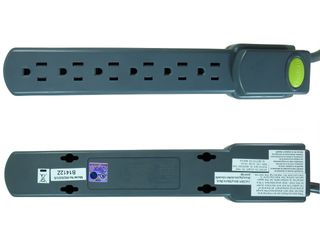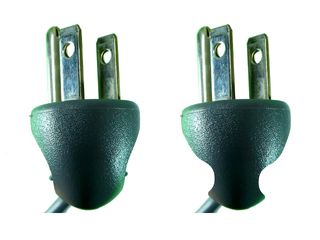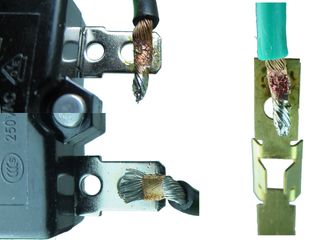Let's Take A Trip Inside Budget Power Bars, Part Two
Let's Take A Trip Inside Budget Power Bars, Part Two

Readers asked for it in the comments of August's SurgeArrest tear-down, and here it is: a mini round-up of bars ranging from the $3 dollar-store to $15 large-store varieties.
Round Two: Some Actual Tearing Required

For this week's power strip tear-down, I bring you three more units. The first two were already reviewed when the first part was published, and after reading comments about “sealed” units, I decided to throw in an extra one, which I labeled as a surprise.
- Kensington's 62630, $10
- Belkin's 106000, $11
- Surprise unit, $??
What is so special about the surprise unit? Stay tuned and find out.
Our Fifth Contestant: Kensington's 62630

This one is a bulk/OEM unit that lacks packaging. It has no switch, does not have a power indicator of any sort but does have a small button breaker on top, next to the power cable entry point. Online specifications claim a 70-joule surge rating and, aside from that, this unit is mostly a mystery. Molded markings contain the usual dry-location warning and mention a 500VL-N protection rating.
Are you seeing what I am not seeing on this unit's rear cover? Screws. Since the bar isn't flexing or making any sound at all as I try to twist it, I conclude it must be welded shut. This is going to be fun.
Kensington's Plug

I wonder how much use-testing went into Kensington's plug design on the left. Those slick and slightly concave sides made of slick rubbery plastic complicate getting a good grip, despite small ridges on the sides. A better design, in my opinion, would have been to carve a groove for fingers to lock into, as GIMPed on the right.
Kensington's Many Labels

I rarely see so many individual labels on one product: one states the presence of a disconnect device to remove surge suppression capabilities at the end of the MOV's working life, there's a warning sticker against daisy-chaining power bars, both in French and English, a sticker re-stating the model number already molded in the plastic, a do-not-dispose-of-in-garbage sticker and UL's holographic sticker. I suppose Kensington did not want to pay for different outer back-cover molds or even sticker prints for each region it wanted to distribute this bar in.
Stay On the Cutting Edge: Get the Tom's Hardware Newsletter
Get Tom's Hardware's best news and in-depth reviews, straight to your inbox.
Time to see if it is easier to break into a Kensington-branded product than break something out of a Kensington lock.
Picking The Kensington

How do you open a welded plastic enclosure? You can chisel it open, you can beat it into submission with a hammer, you can melt it open with a hot wire or knife, you can use a router to cut it open...there are so many options. Routing, sawing and Dremel cutting would create a mess, so I picked a humble clamp and screwdriver bit combo to apply pressure on strategic points.
I was expecting one of the side wall joints to come apart first, but the middle popped instead. A few more pushes and the whole joint on the left side unzipped.
Clean Break

The Kensington's pressure points responded quite favorably to my treatment; it opened with almost no damage aside from the cracked welds, mostly around the perimeter. There were some welded seams inside as well, such as around the inner box to the left.
As I was working my way into this unit, I noticed how awfully familiar the external shape seemed: aside from the missing switch cut-out and the Kensington badge, the outer shell is almost identical to the Electro and Noma bars.
Spilling Kensington's Bits

Similarities with the Electro and Noma end there, though. Instead of soldering its strips and MOV directly to the switch, which this unit lacks, Kensington has a small circuit board for the MOV and its thermal fuse with a button-style breaker located next to the cable's entry point. The only differences in the internal molds are accommodations for the different component layout and alignment pins instead of screw pits.
Kensington's Circuit Board

This little PCB was meant to have a live-ground MOV on the other side of that AUPO thermal fuse to complement the GNR 14D201K across live-neutral and a protection status indicator. There are no isolation slots between live and neutral, and there is a completely unnecessary jumper link between the neutral wire and MOV, which is very odd.
Kensington's Many Connection Styles

The live and neutral strip connections are soldered, while the ground wire gets tinned and spot-welded directly on the ground strip. One of the breaker's connections is tin-plated wire spot-welded on the tab, while the other is tinned bare copper, also welded directly on the tab with mixed results.
Kensington's Mixed Results

The mixed solder and spot-weld joints at the top-left and right are full of pits; it looks like molten copper stuck to the welding electrode and got pulled away with it. The bottom-left weld on platedcopper wire looks much cleaner. Was the tinning only intended to hold the strands together for welding or using the welder for a quick solder reflow? Flux around the wires point toward the latter, in which case the welder appears to have missed his mark.
-
Deemo13 Great article! I didnt really know that these power strips were that different, I am definitely using some ancient ones. I should probably replace them.Reply -
daveys93 I have a powerstrip/surge protector that powers off some of the powerstrip outlets based on the on/off state of one of the outlets. For example: I have my water-cooled PC plugged into the master outlet on the strip and then my speakers, monitors, etc. plugged into the slave outlets on the strip. When I put my PC in windows sleep mode or turn it off, the power strip senses the low power state and turns off the monitors, speakers, etc. There is even a few outlets on the strip that are not linked to the master so I can have my router and cable modem plugged into those and they will not be powered off when I put my PC to sleep. When I wake my PC with the keyboard or mouse, the power strip senses the master outlet on the strip as active and turns my monitors and speakers, etc. back on.Reply
I am generally not a fan of Monster products, like their cables and what not are just overpriced and bulked up to look expensive, however their "Greenpower" powerstrips are great and I think good value for the money and the unique power saving feature. I love not having to power down 3 monitors and my speakers everytime I put my PC to sleep or shutdown.
http://electronics.monsterproducts.com/search?site=allsites&asug=&view=grid&w=greenpower -
Daniel Sauvageau Reply
There are countless generic bars out there and it would be nearly impossible to have a look into all of them. Many of those will simply be re-branded variants of something else and at a glance, the "Koppla 6" I am seeing on Ikea's website looks an awful lot like the Sunbeam unit from part one so I would expect it to be the same thing except possibly for the non-missing thermal shut-off.14866297 said:Anyway you could pick up those IKEA strips and test? -
HarrisburgPA Ever thought about pulling apart something beefier like a Tripp Lite Isobar? I realize this series focuses on budget strips, but it would be nice to see a well-built unit for comparison.Reply -
daveys93 I have a powerstrip/surge protector that powers off some of the powerstrip outlets based on the on/off state of one of the outlets. For example: I have my water-cooled PC plugged into the master outlet on the strip and then my speakers, monitors, etc. plugged into the slave outlets on the strip. When I put my PC in windows sleep mode or turn it off, the power strip senses the low power state and turns off the monitors, speakers, etc. There is even a few outlets on the strip that are not linked to the master so I can have my router and cable modem plugged into those and they will not be powered off when I put my PC to sleep. When I wake my PC with the keyboard or mouse, the power strip senses the master outlet on the strip as active and turns my monitors and speakers, etc. back on.Reply
I am generally not a fan of Monster products, like their cables and what not are just overpriced and bulked up to look expensive, however their "Greenpower" powerstrips are great and I think good value for the money and the unique power saving feature. I love not having to power down 3 monitors and my speakers everytime I put my PC to sleep or shutdown.
http://electronics.monsterproducts.com/search?site=allsites&asug=&view=grid&w=greenpower -
Daniel Sauvageau Reply
I did not have much success getting manufacturers to send me review samples the first time I asked for some but now that I have a few of these out, I might have better luck.14870712 said:Ever thought about pulling apart something beefier like a Tripp Lite Isobar? -
Steelwing I'd love to see a review someday that included non-sacrificial surge protectors (that don't use MOVs), such as units from SurgeX, Brickwall, or Zero Surge.Reply
From what I'd seen and heard, they can deal with extremely high surges with no problems, and they (supposedly) don't wear out. They are considerably more expensive, though. There are a few videos on YouTube of them being tested. -
eidol I've stopped reading articles in this ridiculous picture-flip format. It's annoying on both a smartphone and a desktop. Is there any way to switch them to a full-form article?Reply
Most Popular






